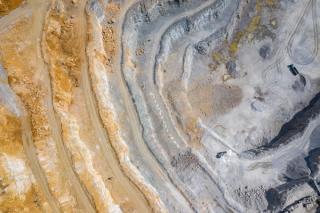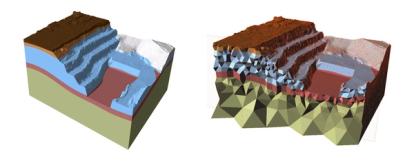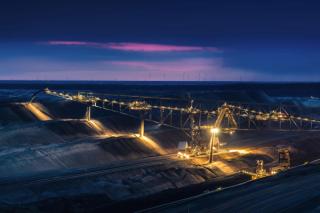
Cultural heritage: Indigenous and cultural heritage values driving sustainable development
by Flavia Kiperman
View post

Geotechnical operations face numerouschallenges, and none more critical than the stability of slopes. A failure could result in catastrophic loss or damage to equipment, infrastructure, and personnel.
It's not just the strength of the materials but a careful balance—a balance we measure, assess, and manage.
Let's explore the key concepts and methods for assessing slope stability; whether you're a site manager or simply curious about the field, a deeper understanding of these concepts and methods can enhance decision-making, improve operational safety, and assist with the long-term sustainability of slope stabilisation projects.
The Factor of Safety (FoS) is a fundamental measure in slope stability analysis. It compares the forces that resist movement, such as the strength of the soil or rock, with the forces that promote movement, like gravity. A FoS greater than 1 indicates a stable slope, while anything below 1 suggests instability.
In simple terms, think of the Factor of Safety (FoS) as a buffer zone. It's like loading a bookshelf: if the shelf is strong enough to support the weight of the books with some capacity to spare, it’s in the safe zone. However, if you overload it, the shelf may bend or collapse. Similarly, maintaining a high FoS for slope face ensures stability, even when subjected to changing conditions such as heavy rain, blast-induced vibrations, or additional loads.
The FoS isn’t static; it changes with the environment and site operations. Seasonal variations, groundwater levels, and modifications to earthworks design can all impact the balance between resisting and driving forces. This is why continuous monitoring and reassessment are essential in slope stabilisation projects.
Several key variables influence slope stability. Cohesion, internal friction angle, and pore water pressure are vital in determining slope behaviour. Cohesion refers to how well particles stick together or the internal bonding strength of rock, while the internal friction angle is how well soil particles or rock surfaces lock together when a force is applied and determines how much the material will resist sliding past each other. Pore water pressure accounts for the water trapped between the soil particles or in the rock cracks, pushing outward against soil particles or rock surfaces, weakening their contact and lubricating and facilitating movement, which can significantly affect stability.
These variables, varying significantly between geotechnical site of interest, require careful consideration. In practice, geotechnical engineers use real-world examples and data to model these variables, predict outcomes, and ensure the proper measures are in place to keep slope face stable.
Two main methods that can be used to evaluate slope stability: the Limit Equilibrium Method (LEM) and the Finite Element Method (FEM). Each method has strengths and weaknesses, and the choice between them often depends on the project's specifics.
LEM is widely used for its simplicity and efficiency. It breaks down a slope into slices, calculating the forces acting on the sides and base of each slice to determine if the resisting forces are greater than the driving forces. LEM is great for quick assessments, its often the go-to method for routine checks, and it's relatively easy to understand and apply
FEM takes a more complex approach, using a mesh of elements, nodes and edges to determine how a slope may behave under different conditions. It examines stress and strain distribution, making it suitable for complex slopes. FEM is especially useful for complex slopes with varying materials, and you want to understand the interactions between different layers of geology. Although it provides in-depth insights, it requires more time and computational resources, making it best for high-risk scenarios or where we need a detailed understanding of material behaviour.
Each method has its strengths. LEM offers faster, more straightforward analysis, making it ideal for quick routine assessments, while FEM provides more significant insights in more complex situations. Both methods have their place in slope stability analysis, and the choice depends on the specific needs of the project.

Modern geotechnical engineering relies on sophisticated software tools to model and assess slope stability. Two commonly used programs are Rocscience Slide 3 and RocFall.
This software specialises in 3D slope stability analysis using the Limit Equilibrium Method. It allows engineers to create detailed 3D models of open-cut pits, incorporating real-world variables like groundwater conditions, material strength, external loading, anisotropic surfaces, and seismic effects.

RocFall, a tool focused on assessing rockfall risks, assists engineers in analysing the potential impacts of falling rocks from slopes. It aids in designing mitigation measures such as rockfall barriers, bunds, and safe exclusion zones while also helping to understand the potential runout distances of falling rocks. By simulating rockfall trajectories, RocFall provides valuable insights to enhance the safety of workers and equipment.
These tools bridge the gap between theoretical analysis and practical decision-making, giving site managers or mine site operators the insights they need to keep operations safe and efficient.

The concepts and tools discussed in this article are crucial for real-world quarry, mine site operations and slope stabilisation works. By analysing the FoS and conducting rockfall assessments, site managers can make informed decisions about excavation limits, drainage solutions, and rockfall barriers. They can also determine safe working distances from pit walls, optimal locations for haul roads, appropriate safety measures to protect site offices and weighbridges, and the safest routes for traffic movement. These proactive measures not only improve safety but also help prevent costly disruptions and prolong the operational life of the site.
Understanding slope stability methods and tools goes beyond simply performing calculations or using software; it’s about making informed, safety-focused decisions that directly impact site operations. Whether employing Limit Equilibrium Methods (LEM) or Finite Element Methods (FEM), analysing slopes in 2D or 3D, or using tools like Slide or RocFall, the ultimate objective remains the same: to safeguard people, equipment, and the environment while ensuring operational efficiency. In the quarrying, mining and other geotechnica industries such as slope stabilisation and foundation engineering, every decision carries significant real-world consequences, emphasising the critical need to balance safety with performance.
For more information on how SLR can support you, please get in touch with us.

by Flavia Kiperman

by Jasper Schrijvers , Matthew Hoare

by Clodagh Connolly, Nicola Inge, Andres Schottlaender